SCRAWLING EDITOONS AND POP’S PLACE
When Your Surname is Rawls and Your Initials are S and C
Cartoonists with a playful turn of mind, which describes most of them, like to give walk-on characters in their oeuvre names that describe their professions. Yankem, for instance, is an obvious name for a dentist. If not Yankem then maybe Fillem. If you had a general in the army who was not quite all there, you might call him Halftrack. (Mort Walker did exactly that in Beetle Bailey.) And if you were looking for a name for a cartoonist, you couldn’t do much better than Scrawls.
And that’s exactly how Sam C. Rawls signed his editorial cartoons and his comic strip—he was one of those rara avis who does both— and every syllable is exactly the truth, no fictional make-believe in sight.
But before Scrawls started cartooning for a living, he wandered around a little, dabbling in journalism and sports reporting.
Scrawls achieved a bachelor’s degree in speech-journalism from Florida Southern College in about 1962. By then, he’d become enamored of a coed, Janet Doyle, who was going to continue her education at Florida State University at Tallahassee. Scrawls followed her to FSU and started working on a masters in advertising and public relations, while contributing illustrations and cartoons to the campus daily newspaper, Smoke Signals.
He also took a job proof-reading at the Tallahassee Democrat. And he did some general assignment news and feature stories. And he submitted illustrations. He was there about a year (probably 1964-65) before losing the job.
He moved to the Ocala Star Banner as a sports writer. And he married Janet. (And they’re still married.)
Scrawls submitted unsolicited cartoons to his editor, but after a year, he was looking for a job again. He found one at the Palm Beach Post-Times, again as a sports writer; again, he submitted cartoons occasionally. After two years (1967-68 or 1968-69; my source doesn’t give dates), he left for the Miami Herald’s Palm Beach bureau.
Then in 1970, the Cox Newspaper Group bought the Palm Beach Post, and Scrawls signed on as staff illustrator, hoping to convince an editor that he should be the paper’s editorial cartoonist. For the next few years, he drew mastheads and logos and graphs—and occasionally submitted an editorial cartoon. Eventually, his scheme worked.
By 1974, he was drawing a daily editorial cartoon and heading a five-man art department. In 1978, he became the paper’s full-time editoonist, doing five editorial cartoons a week.
In 1976, the Newspaper Enterprise Association (the NEA syndicate) began distributing Scrawls’ editorial cartoons every week to a national audience.
Then in 1979, the Cox-owned Atlanta Journal hired Scrawls as its political cartoonist. That job lasted only three years: the Journal was conservative, and Scrawls was liberal. In 1982, he moved up—from the sixth to the eighth floor in the Journal-Constitution building to become editooner for the Atlanta Constitution, where he was more comfortable editorially.
The Constitution “has a proud history of progressive editorial policy,” reported Sandy Campbell, editoonist for the Nashville Tennessean, which is where he was when he wrote a long and lively article about his friend Sam Rawls for Jud Hurd’s Cartoonist PROfiles (No.70, June 1986).
“In the 1950s,” Campbell continued, “the Constitution’s editor, Ralph McGill, was acclaimed nationwide for his sensitive writing about social issues, especially civil rights. He was also vilified occasionally at home.”
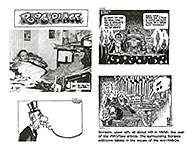 |
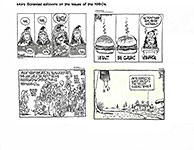 |
And so, presumably, was Sam.
“Sam has used his space to attack bigotry, condemn demagogues and challenge reactionary policies at every level of government. By doing so he has come to feel some of the same kinds of stings that must have beset McGill. While he has never dodged a good ideological fight, Rawls looks elsewhere for something of a safe haven.” A comic strip.
IN LATE MARCH 1986, Rawls launched himself into a second daily grind with a comic strip. He’d been thinking, vaguely, about doing a comic strip starring the owner of a bar—“an affable publican,” as Campbell puts it—and the affable one’s interaction with friends and customers, who, in constant variety, would provide ample fodder for comedy. He entitled the strip Pop’s Place.
“Hasn’t
just about every man wanted at some time in his life to own a pub?” Scrawls
asked Campbell rhetorically. “I know I have. Now I get to own one, and it’s the
warm friendly place I always thought it would be. The best part is I get the
pub without the overhead. With Pop’s Place, I don’t even have to buy a
liquor license.” 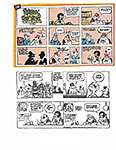
If you look at the Sunday Pop’s Place that’s in color on the nearby visual aid, you’ll be looking at the reason we have this posting. Here’s how it happened—:
I subscribe to a nostalgia magazine called Remind. Among the fragments of the past that it regularly floats by us readers are a couple vintage comic strips, different ones in each issue. Sunday strips usually. In a recent issue, it published the Sunday Pop's Place we’ve just been looking at.
I stared at it because I'd never heard of Pop's Place. And if you consider how I’ve been spending all my waking hours for the last 22-plus years, cranking out Rancid Raves and contemplating comic strips through the 100-plus years of their history, you'll realize what a shock it was for me to encounter a comic strip that I hadn't heard of.
Desperate to know more, I looked up Scrawls in my index to Cartoonist PROfiles, and I saw that there'd been an article about Pop's Place. So I dug up that pertinent issue and made myself acquainted with Pop’s Place. And Scrawls. And most of this posting is shamelessly borrowed from the PROfiles article. And now, we go back to borrowing, forthwith—:
Scrawls picked the summer of 1985 to devote to developing the strip. It might not have been the best time for him to indulge in that activity.
He had just come off a work-intensive year as president of the Association of American Editorial Cartoonists. The main job of the prez of AAEC is to organize and produce the group’s annual convention, which, in 1985, was in Orlando, Florida, at Disney World, May 8-11. The task required a full year of concentrated effort.
Said Scrawls: “The pressure of trying to put on a successful convention is tough, and when it begins to wind down, you are left feeling pretty much drained.”
His AAEC predecessors had warned him, advising him to plan a post-convention vacation before returning to the drawing board. But Scrawls had other notions.
“My idea was to go fishing,” he said, “but all my fishing buddies had to work, so I spent the time concentrating on developing the strip.”
In other words, he just amped up the time he spent at the drawing board, throwing the advice from his peers into the nearest round file.
Scrawls went to work to build up a healthy pile of rough ideas for the daily installments of the strip before he approached a syndicate with his concept. First he had to convince himself that he could sustain a strip for weeks—months—years. Finally, after a few weeks, he was convinced. He did finished art on the best 30 dailies, bundled them up, and started sending them off to syndicates.
King Features seized upon Pop’s Place enthusiastically: its editor, Bill Yates, promptly invited Scrawls to King’s New York office to discuss a contract.
“Drawing Pops is a dream-come-true,” Scrawls told Campbell, “but I think of it as a second job. I like drawing editorial cartoons too much to ever quit doing them.”
But the strip offered a safe harbor from editooning, too.
“Pops is not the kind of character who should spark controversy,” Scrawls said. “It’s time I got some friendly letters instead of hate mail” (the typical mail an editoonist gets).
And
Pops is friendly. We see him most often behind the bar. He’s a short, somewhat
chubby man who wears a t-shirt emblazoned with the name of a sports team and a
baseball cap, pulled down over his eyes and balanced on a nose the size of a
medium-sized watermelon. 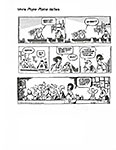
Rawls didn’t think that comic strips necessarily must aim for a narrow demographic: he believed Pops had general appeal. The gags were family-oriented, based upon everyday events in the lives of everyday people. Most of the characters were adults, but, because Pops was a Little League coach, the opportunity always existed for kid-oriented humor.
Although he intended to keep wearing his editoonist hat, Scrawls insisted that he would not allow politics to creep into Pop’s Place— except in the broadest sense. For example, Pops, who was white, had a best friend and partner named Harve, who was black. The cartoonist said this was not a political statement but rather an indication of Sam Rawls’ attitude about friendship.
“Look, Pops is in a way autobiographical,” he said. “He likes kids, fishing and team sports just like I do. They say a first-time novelist should stick to what he knows about, and the same just might be true for a first-time comic strip creator.
“Since I identify so closely with Pops,” Scrawls went on, “I asked myself what kind of people would I want to be surrounded with. Why not a Black guy? Pops and Harve are friends because they like and respect each other not because they have different colored skins. That bond of genuine friendship holds true for Enid the waitress, the professor and every other regular character in the strip.”
Rawls credited his father for teaching him the value of friendship.
“My dad used to say ‘If you have friends you can never be a failure.’ That was his motto. It’s also Pops’ and mine.”
Pop’s Place started March 24, 1986; our best information is that Pop’s Place Sundays stopped in 1993; the dailies continued until April 7, 2002.
SCRAWLS was born May 30, 1940 in Clarksdale, Mississippi, “deep in the heart of God’s country,” as he put it. But he grew up all over. His father was a dragline operator who traveled to wherever the construction jobs were, and the son’s formative years were spent packing and unpacking all around the state of Florida. He attended 11 different elementary schools.
When he reached highschool age, his mother put her foot down.
“We’re not moving the boy anymore,” she declared.
And “the elder Rawls found enough local construction work to permit Sam to enroll in and graduate from Fort Lauderdale High School,” reported Campbell.
“Sam remembers one Florida stopover with a special fondness,” he continued. “It was in Sebastian that he learned to appreciate sports and the radio. ‘There wasn’t anything else to do,’ he explained.
“Sam started listening to St. Louis Cardinals games on the radio and developed a passionate love for the team that continued all his life.”
“My father didn’t understand about my drawing,” said Sam. (It was his mother who loved to draw.) “My father wanted me to be some kind of businessman. His idea of success was wearing a white shirt and tie to work every day.”
“Ironically,” said Campbell, “Sam has found his niche in a profession where success means no one can MAKE you wear a white shirt and tie to work every day.”
Sam Rawls big adventure in his youth was painful, Campbell reports.
“While a senior at Florida Southern College, he took a summer job in construction. He was working with a gas welder when the machine blew up, burning him severely on the right side.”
Said Rawls: “The doctor told me that I had a 50-50 chance of losing my right hand. There was also a real danger I could have lost part of my right leg.”
“But Sam was lucky,” said Campbell. “He left the hospital three months later with his limbs intact, permanently scarred and temporarily hobbling on a cane but fit enough to finish his final months at Florida Southern. He also left with a new maturity.”
Rawls remembers: “Lying in the hospital bed, I thought about how I had been spared. I thought about using my talents, about giving cartooning a serious try.”
Doing a daily editoon and a daily comic strip translates into monumental seriousness. And Scrawls didn’t stop there. He illustrated several books about “Southern” culture. How to Speak Southern is one of them; and it’s still in print, his wife Janet told me. His other titles include How to Speak Fishing, How to Speak Bulldawg, More How to Speak Southern, and The Willie Nelson "Cooked Goose" Cookbook and IRS Financial Advisor. And he both wrote and drew The Redneck Instruction Book.
SCRAWLS WAS LUCKY ENOUGH to be born in Clarksdale, good Redneck country. And he remained in prime Redneck territory when he attended Florida Southern College. With these bonafides, he was well qualified to write an instruction book about Redneckery.
By the mid-1990s, according to a promotion for Scrawls’ book, “Redneck-mania was sweeping across the country, and it became more and more acceptable and respectable to admit that one is a Redneck. By their very nature, Rednecks eschew trendiness, political correctness, and calorie counting.
“They believe that ‘yards aren’t complete without a pink flamingo statue,’ and they ‘wear caps advertising fertilizers or tractors.’ Rednecks ‘are sure that only women should wear earrings’ and ‘love to hunt their own food.’ Speaking of food, they ‘have enjoyed Moon Pies and R.C. Cola’ and ‘think it ain’t food if it ain’t fried.’ Rednecks also have a more respectful, honest, genteel manner. For example, they ‘always say ma’am and sir,’ ‘are loyal to a fault,’ and ‘usually tip more than they should.’”
Yes,
Scrawls’ little Redneck book is comical, and his drawings add lots to the
comedy as we can tell from the Scrawls art that graces the book’s cover.
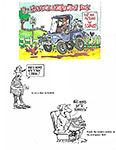
When I first bought the book, I stared at the cover for a couple weeks. I put the book on the counter next to where I go for my morning pill-intake, so it was convenient to my wandering eye, and I studied the cover drawing. I eventually decided that it was as nearly perfect a cartoon drawing as we’re likely to see.
Trucks and automobiles are hard for a cartoonist to draw. All that inanimate stuff—hoods and doors and wheels. Straight lines and complicated mechanicals. Scrawls solved all of those difficulties by simply eliminating the parts he doesn’t like to draw.
There’s a wheel axle for the back wheels but nothing in front. The axle in the front of a truck would be complicated by connections to steering mechanisms, so rather than giving himself the trouble of drawing all that, Scrawls just eliminated the complication by eliminating the front axle.
And in back, the axle is entirely detached from function. As are the wheels themselves. They’re just floating along in the position that wheels occupy, usually. And yet, the “impression” of a truck is perfectly conveyed. And no telling visual detail is left out. Notice that the tailgate of the truck is open, held to the vehicle by a chain, of course.
Where the truck driver’s lower body goes I dunno. There’s not room for it to be sitting where it’s sitting. Unless his legs are extended straight out from the hips, occupying the place where the truck motor usually goes.
But we don’t worry about such trifles. The impression of the truck, a comedic one, is all we really need. Alex Raymond isn’t what Scrawls is; but what he is, is just fine for what he does.
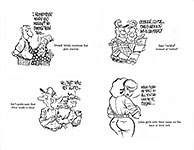 The
rest of the picture—the chicken racing for its life, the hound dog drooling,
the bird on the fencepost and the cow in the distance—all nicely cartooned.
The
rest of the picture—the chicken racing for its life, the hound dog drooling,
the bird on the fencepost and the cow in the distance—all nicely cartooned.
The whole thing makes me smile. But I come back to the disembodied wheels every time I look at the picture.
Once we get past the book’s cover, we can see the rest of the comedy inside, samples sof which are posted near here, just bursting with his scrawled, juicy line.
SCRAWLS EVENTALLY MOVED ON from the Atlanta Constitution. He became editorial cartoonist for the Rockdale Citizen (Conyers, Georgia) and Creative Loafing Magazine (Atlanta).
He was a staunch environmentalist from his youth, Janet told me—proclaiming himself a "tree hugger/ bark-eater"— and he was greatly disturbed at the idea of DuPont strip-mining property just outside a swamp park’s boundaries. He appealed to editorial cartoonists all over the U.S. for cartoons defending swampland.
Said Janet: “He loves Florida, and the conservation awards he received from Florida Wildlife Federation are some of his most treasured. When he came to Georgia, the Okeefenokee was an extension of his love for those Florida swamps. He still will rant and rave about what we are doing to our planet.”
Another award among his most treasured is the Robert F. Kennedy Award that he received for exposing the problems of the disadvantaged Janet told me.
When last seen (maybe around 2013), Scrawls was drawing cartoons for the Initiative for Preserving Jekyll Island (Georgia). He found humor in the Jekyll Island Authority's assertion that marsh should be counted as "land" to determine the size of the island for development purposes.
At
savejekyllisland.org/CartoonsNew.html, “everyone knows the JIA does not intend
to build IN the marsh, but adding marsh acres to grow the size of the island
would give the JIA more acres to develop on actual dry land when applying the
appropriate laws, which prohibit subdivision, improvement, lease and/or sale of
‘not more than thirty-five percent (35%) of the land area of Jekyll Island
which lies above water at mean high tide.’ 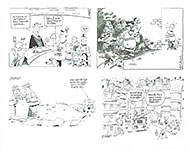
When not hunched over the drawing board, Scrawls liked to get into his bass boat and fish the fresh water lakes of Florida and Georgia. He also coached youth baseball and football teams “and is a pretty fair softball player himself,” said Campbell.
When his family (a daughter and a son) were still at home, he spent time with them.
And he rode horses.
Campbell
doesn’t mention Scrawls’ horseplay, but the issue of PROfiles in which
the Scrawls article appears features a photograph of Sam on horseback on the
cover; we’ve posted it hereabouts. 
And you can tell that Scrawls is strenuously putting the horse through its paces. Until I saw this photo, I never realized that horses corner by tilting just like motorcycles do. And now I know. (And so do you.)
When asked once about the future, Scrawls simply said he hopes he’ll always be able to draw. I hope he can, too. He and Janet retired a few years ago, so he isn’t required to draw anymore. But at the age of 81, Scrawls may still be scrawling for his own amusement.
FITNOOT. The foregoing effusion appeared at The Comics Journal website in August 2021, and in its first iteration, before being posted, I concluded it by wondering where Scrawls was, if he was still cartooning and so on. The website tcj.com editor, Tucker Stone, found a phone number and he thought might lead to Scrawls, so he passed it on to me. I phoned, and Janet Rawls, Scrawls’ wife, answered.
I sent her the article, and she offered a couple of suggestions (which I incorporated into the piece) but mostly applauded its accuracy (Sandy Campbell’s accuracy, that is). She also asked if I wanted to speak to Sam. Well, I wanted to but I declined: I’m about half deaf (the problem is, I don’t know which half), and telephone conversations consist largely of me saying “What? What’s That?” over and over.
Janet told me Sam is hard of hearing, too, which would make our conversation doubly frustrating. And so I’ve quoted Janet rather than Sam in recounting my contact (non-contact) with Scrawls.
